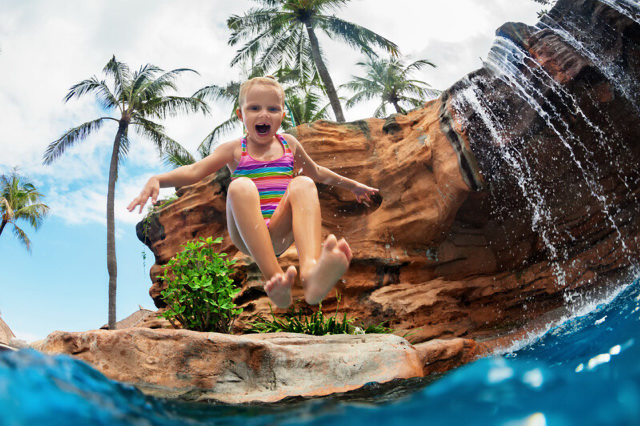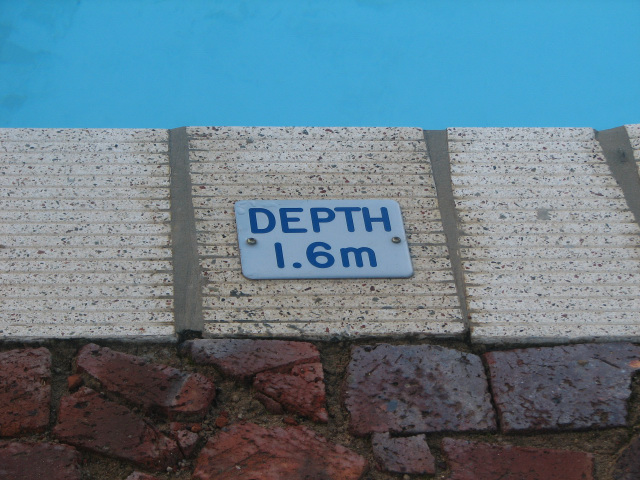You’ve decided it would be a whole lot of fun to have a jumping rock for your swimming pool. Since this will be your first jumping rock, you have no idea what the appropriate depth for your pool should be. How deep must your swimming pool go?
The depth of a swimming pool with a jumping rock should be from 4 to 9 feet (1 to 3 m). The depth will depend on the height of your jumping rock. For rocks a few feet above the water surface, 4-5 feet (1-2 m) in depth is OK. A jumping rock that is 10 feet (3 m) high will require a pool water depth of around 9 feet (3 m).
In this article, we’ll tell you everything you need to know about jumping rocks. That includes pool manufacturers’ recommendations and state laws and regulations about installing jumping rocks around your pool. You won’t want to miss it!

Article Contents
3 Pool Manufacturers’ Recommendations for Jumping Rock Pool Depth
First, let’s delve deeper into the recommended pool depth for jumping rocks. We found suggestions from three swimming pool builders and want to share them with you in this section.
The suggestions come from Edgewater Pools, American Pools & Spas, and River Pools. Although they don’t always directly address jumping rocks, we can gain some insights for the safe depth for jumping into a pool.
Let’s take a closer look.
Edgewater Pools
Edgewater Pools in Ottawa, Ontario, Canada says that when adding a jumping apparatus to your swimming pool, such as a diving board or a jumping rock, then the pool should be eight feet deep.
Here’s the statement from the pool company in full: “If you plan to install a diving board, 8 feet (2 m) is the minimum depth you will need in the deep end. This depth is deep enough for diving in safely with a diving board. And there is usually no need for a pool to be deeper than 8 feet (2 m).”
American Pools & Spas
American Pools & Spas also weighed in on this topic. They’re an Orlando, Florida swimming pool manufacturer. Here’s what they recommend: “People jumping in need enough water to absorb the force of their jump, so it’s necessary to have a depth of at least 4 feet (1 m). When diving headfirst, having sufficient depth to avoid injury is vital. The recommended depth is a minimum of 9 feet (3 m).”
River Pools
Warsaw, Virginia pool manufacturer River Pools echoes the sentiments expressed by American Pools & Spas and Edgewater Pools. Here’s what their website stated: “Quick fact: a pool needs a minimum 8 feet (2 m) of water along with meeting other specifications. That’s actual water, not just the depth of the pool. The legal length and height restrictions on diving/jumping boards are relative to the size and depth of the pool.”
So, looking at the recommendations from the three pool builders, we can deduce that the best pool depth for jumping rocks is between eight and nine feet (2 and 3 m). Not only is this a preference, but–as you’re about to see–it’s the law.
Pool Depth Laws for Jumping Rocks
Let’s talk further about the pool depth laws. These laws can and do vary from one state to another in the United States, in general, the recommended pool depth when diving is at least nine feet (3 m), says the American Red Cross.
Keep in mind that most of the regulations and laws cover diving boards rather than jumping rocks. Even still, we’ll now take a closer look at the pool depth laws in New York state.
New York Pool Depth Laws
The New York State website categorizes its rules on swimming pools in a document known as Title 10, specifically Part 6 – Swimming Pools, Bathing Beaches and Recreational Aquatic Spray Grounds.
The information about swimming pool depths is contained in SubPart 6-1 – Swimming Pools within Operation, Supervision, and Maintenance, Title: Section 6-1.29 – Swimming pool design standards.
In Section 5.2 of that document are requirements on minimum swimming pool depth. The document states as follows: “The minimum depth of water in the pool shall be three feet (1 m), except for special-purpose and wading pools.”
Further in the document are dimensions of swimming pools according to the diving board height. Although the document doesn’t mention anything about jumping rocks, we can get a good idea of the safe pool depths by looking at this document.
Here’s what you need to know:
- For 10-foot (3m) diving boards that are 26 inches (66cm) over the water, the depth of the pool must be eight feet (2 m), six inches deep (15 cm), and the width 20 feet (6 m).
- For 12-foot (4 m) diving boards that are 30 inches (76 cm) over the water, the depth of the pool must be nine feet deep (3 m) and the width 20 feet (6 m).
- For 16-foot (5 m) diving boards that are a meter (100 cm) over the water, the depth of the pool must be 11 feet (3 m) deep and the width 20 feet (6 m).
- For 16-foot (5 m) diving boards that are three meters (300 cm) over the water, the depth of the pool must be 12 feet (4 m) deep and the width 24 feet (7 m).
If you’re tossing up between a pool slide and a jumping rock, we have an article about the pool depth needed for a slide here.
Factors that Influence the Pool Depth for a Jumping Rock
The biggest factor to keep in mind when planning out your jumping rock is the distance from the rock edge to the water. The higher the rock, the deeper your pool needs to be.
Olympic diving pools, such as the pool that was used in the 2021 Tokyo Olympics is approximately 16.5 feet (5m) deep. Of course, the athletes dive from almost 33 feet (10m). Unless you have a mansion, it’s unlikely your jumping rock will be that high and need a pool that is 16.5 feet (5m) deep.

Other Requirements for a Jumping Rock
It’s not just the depth of the pool you need to take into consideration. Other factors include:
- The amount of space in front of the jumping rock
- The amount of space on either side of the jumping rock
- The passage to get to the jumping rock
Having enough room directly in front and to the sides of the jumping rock is just as important as having a deep enough pool. It’s likely that jumpers could jump several feet forward when they launch off of the rock.
You certainly don’t want to come crashing into the opposite pool wall. Depending on the height of your jumping rock, you will need up to and 13 feet (4 m) in front of the rock.
Same with the distance either side of your jumping rock. Just like a pool slide, you’ll need adequate space. For example, larger pool slides require up to 3’ (91 cm) of space on each side of the slide.
Related Reading: Best Pool Depth for a Pool Slide (3 Builders Weigh In)
Are Jumping Rocks Dangerous?
You still have some questions about jumping rocks, and we’re here to answer them. For instance, how safe are they? You’re mostly interested in adding a jumping rock to your swimming pool for the kids, but not if they’re going to break a leg or worse.
Jumping rocks can be safe, but there are certainly dangers present. Injuries caused by diving into water can be severe. The American Redcross says that most diving injuries occur in less than 5 feet (2 m) of water.
To minimize the likelihood of injuries you want to ensure your pool is deep enough. One of the benefits a jumping rock has over a diving board is that the rock doesn’t have any bounce or give to it like a diving board. When you jump off the rock, you’re not being propelled upward.
However, the smooth texture of a jumping rock can make it a slipping hazard. By getting the rock textured like you would a diving board, this becomes less of an issue.
Any apparatus that allows a swimmer to propel themselves off it will always pose some risk. It’s for that reason that we’d tell you to refrain from having very young kids use the jumping rock. Your rock likely has a weight limit, just as diving boards do, so make sure you adhere to that weight limit as well.
Can You Dive Off a Jumping Rock?
Jumping rocks are named that since you’re supposed to jump off them, but what about diving? Yes, you most certainly can dive off a jumping rock.
However, we must state a few caveats. One is the matter that we’ve been discussing the entire time, pool depth. Remember, the American Red Cross recommends that a diving pool be at least nine feet (3 m) deep. This will of course depend on the height of your jumping rock.
You’ll also want to make sure there is enough clearance at the front of the jumping area and to the sides to avoid injuries.
Related Reading: The Ultimate Guide to Plunge Pools (Costs, Size, Maintenance)
How Much Do Jumping Rocks Cost?
You’ve decided that you’d like to treat the kids this summer to their very own jumping rock for the pool. How much money will you have to set aside for this investment?
The cost for the rock itself is as low as $300 and up to $2,000. That’s before you factor in installation prices though. Swimming Pool Quote states that the entire project–with the cost of the jumping rock and installation rolled in as one–is $5,000.
That makes a jumping rock cheaper than a splash pad, which Swimming Pool Quote has priced at $10,000. Getting a diving board costs on average around $3,000, so a pool rock is slightly more expensive.
The above prices are assuming that your swimming pool is already designed for a jumping rock. If you need to widen your pool or make it deeper to accommodate the rock, the cost of this project could be thousands of dollars more.
Conclusion
A jumping rock on the edge of the pool will provide lots of entertainment for the kids over many summers to come. You must ensure your pool is between eight and nine feet (2 and 3 m) deep for this addition, especially if your kids want to dive from the rock. Be safe and stay cool!

